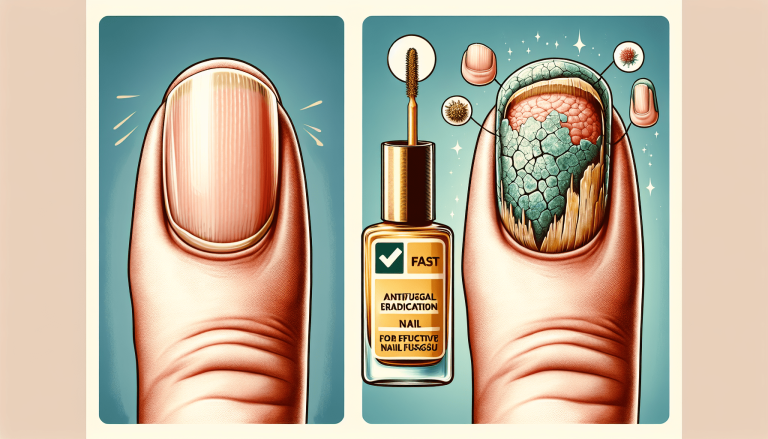Can Foot Fungus Go Away On Its Own?
Have you ever wondered if foot fungus can go away on its own? Well, the good news is that in some cases, it actually can! While foot fungus is a common condition that can cause discomfort and embarrassment, it is often treatable with over-the-counter medications and good hygiene practices. However, it’s important to understand that every case is unique, and seeking medical advice is crucial to ensure proper treatment and prevent the infection from spreading.
Understanding Foot Fungus
What is foot fungus?
Foot fungus, also known as athlete’s foot or tinea pedis, is a common fungal infection that affects the feet. It is caused by various types of fungi that thrive in warm and moist environments. Foot fungus typically develops in the warm and damp areas between the toes or on the soles of the feet. If left untreated, it can spread to other parts of the body or to other individuals.
Causes of foot fungus
The main cause of foot fungus is the overgrowth of fungi, particularly dermatophytes, on the skin of the feet. These fungi thrive in warm and moist conditions, making sweaty or damp feet a prime breeding ground. Fungi can also spread through direct contact with an infected person or by coming into contact with infected surfaces such as gym floors or public showers. People with weakened immune systems, diabetes, or poor circulation are more susceptible to foot fungus.
Common symptoms of foot fungus
Foot fungus can present a variety of symptoms, ranging from mild to severe. The most common symptoms include:
- Itching and burning sensation: One of the primary signs of foot fungus is persistent itching and a burning sensation between the toes or on the soles of the feet.
- Redness and inflammation: The affected skin may appear red, swollen, and inflamed. In some cases, blisters may also develop.
- Peeling or cracking skin: Foot fungus can cause the skin to peel and crack, especially between the toes.
- Dry and flaky skin: Infected areas may become dry and flaky, leading to discomfort and irritation.
- Foul odor: Foot fungus can cause a foul odor due to the multiplication of bacteria on the infected skin.
Self-Management and Prevention of Foot Fungus
Maintaining proper foot hygiene
Proper foot hygiene is essential in preventing and managing foot fungus. Make sure to wash your feet thoroughly with soap and warm water every day. Pay special attention to the spaces between your toes and dry your feet thoroughly after washing.
Wearing clean and breathable socks
To prevent foot fungus, it is crucial to wear clean and breathable socks made of natural materials like cotton. Avoid synthetic materials that can trap moisture on the skin.
Using antifungal powders or sprays
Antifungal powders or sprays can be used as a preventive measure to control foot fungus. These products work by creating an unfavorable environment for the fungi to grow and thrive.
Avoiding sharing personal items
To prevent the spread of foot fungus, avoid sharing personal items such as towels, socks, shoes, or nail clippers with others. Fungi can easily transfer from one person to another through these items.
Minimizing exposure to damp environments
Since fungi thrive in damp environments, it is important to minimize exposure to such places. Avoid walking barefoot in public showers, gyms, and swimming pools. Always wear protective footwear, such as shower shoes or sandals, in these areas.

Over-the-Counter Treatments
Antifungal creams
Antifungal creams are commonly used to treat foot fungus. These creams contain active ingredients that target the fungi and inhibit their growth. Apply the cream to the affected areas as directed, usually twice a day for several weeks.
Topical ointments
Topical ointments, similar to antifungal creams, are effective in treating foot fungus. They provide a thicker and more protective barrier on the skin, which helps in reducing symptoms and promoting healing.
Antifungal powders
Antifungal powders are useful for preventing and managing foot fungus. These powders work by absorbing excess moisture and keeping the skin dry. Apply the powder to your feet and in between your toes to control the growth of fungi.
Sprays and mists
Antifungal sprays and mists are convenient and easy to use. They effectively deliver the antifungal ingredients to the affected areas, providing relief from symptoms and preventing the spread of fungus. Follow the instructions on the product label for proper usage.
Home Remedies for Foot Fungus
Tea tree oil
Tea tree oil has natural antifungal properties and can help alleviate foot fungus symptoms. Dilute a few drops of tea tree oil with a carrier oil, such as coconut or olive oil, and apply it to the affected areas twice daily. Make sure to patch test before using it on larger areas.
Apple cider vinegar
Apple cider vinegar has acidic properties that can help control the growth of fungi. Mix equal parts of apple cider vinegar and water in a basin or tub, then soak your feet in the solution for about 15-20 minutes. Repeat this process daily until symptoms improve.
Garlic
Garlic is known for its antifungal properties. Crush a few cloves of garlic and mix them with a carrier oil or add them to a foot bath. Soak your feet in the solution for 20 minutes, then rinse and dry thoroughly.
Baking soda
Baking soda can help neutralize the pH of the skin, making it less favorable for fungal growth. Create a paste by mixing baking soda with water and apply it directly to the affected areas. Leave it on for 10-15 minutes before rinsing off.
Oregano oil
Oregano oil contains compounds that have antifungal properties. Mix a few drops of oregano oil with a carrier oil, such as coconut oil, and apply it to the affected areas. Repeat this process twice a day until symptoms improve.

When to Seek Medical Attention
Persistent or worsening symptoms
If your foot fungus symptoms persist or worsen despite using over-the-counter treatments or home remedies, it is recommended to seek medical attention. A healthcare professional can evaluate your condition, provide appropriate treatment, and ensure there are no underlying causes contributing to the infection.
Severe pain or discomfort
Experiencing severe pain or discomfort in your feet due to foot fungus warrants medical attention. Foot fungus should not cause extreme pain, so it is important to have a healthcare professional assess the severity of your symptoms.
Presence of underlying health conditions
If you have an underlying health condition such as diabetes or a weakened immune system, it is crucial to consult a healthcare professional. These conditions can make foot fungus more challenging to treat and may require specialized care.
Risk of spreading infection
If your foot fungus is spreading to other parts of your body or to other individuals, it is important to seek medical attention. This can help prevent further complications and ensure appropriate treatment to control the infection.
Medical Treatments for Foot Fungus
Prescription antifungal medications
Prescription antifungal medications are often recommended for more severe or persistent cases of foot fungus. These medications can be taken orally or applied topically, depending on the severity and location of the infection. It is important to follow the instructions provided by your healthcare professional carefully.
Oral medications
For systemic or widespread foot fungus infections, oral antifungal medications may be prescribed. These medications help eliminate the fungi from within the body. As with any medication, it is essential to follow the prescribed dosage and duration to ensure effectiveness and minimize potential side effects.
Topical antifungal solutions
In some cases, healthcare professionals may prescribe stronger topical antifungal solutions or creams that are not available over the counter. These medications contain higher concentrations of active ingredients and can be more effective in treating stubborn foot fungus.
Laser therapy
Laser therapy is a relatively new treatment option for foot fungus. It uses high-energy laser beams to target and destroy the fungi. Laser therapy is often considered when other treatments have failed or as an alternative to oral medications.
Surgical removal of infected nails
In severe cases of foot fungus where the infection has spread to the nails, surgical removal of the infected nails may be necessary. This procedure is typically done under local anesthesia and can help eliminate the source of infection.
Complications and Risks of Ignoring Foot Fungus
Spread of infection
If left untreated, foot fungus can spread to other areas of the body, such as the groin or hands. It can also be transmitted to other individuals through close contact or sharing personal items, leading to the development of fungus in different areas of the body.
Secondary infections
Foot fungus can create small cracks and breaks in the skin, creating an entry point for bacteria to invade, leading to secondary infections. These secondary infections can be more challenging to treat and may require additional medical intervention.
Nail deformities
Foot fungus can cause nail deformities, such as thickening, discoloration, and brittleness. If the infection spreads to the nails, it can lead to permanent changes in nail growth and appearance.

Chronic foot pain
In some cases, foot fungus can cause chronic foot pain due to persistent inflammation and damage to the skin and nails. This can significantly impact a person’s quality of life and ability to engage in physical activities comfortably.
Preventing Recurrence and Reinfection
Continuing good foot hygiene practices
To prevent recurrence and reinfection of foot fungus, it is important to maintain good foot hygiene practices. Regularly wash and thoroughly dry your feet, paying special attention to the spaces between your toes. Avoid wearing damp or sweaty shoes for extended periods and change your socks regularly.
Regularly disinfecting footwear
Disinfecting your footwear regularly can help kill any remaining fungi and prevent reinfection. Use antifungal sprays or powders specifically designed for shoes and allow them to dry completely before wearing them again.
Avoiding shared public spaces without protective footwear
To reduce the risk of reinfection, it is advisable to avoid walking barefoot in shared public spaces such as public showers or locker rooms. Always wear protective footwear, such as shower shoes or sandals, to minimize direct contact with potentially contaminated surfaces.
Wearing breathable socks and shoes
Choosing breathable socks and shoes can help prevent excessive sweating and moisture buildup, creating a less favorable environment for fungal growth. Opt for socks made of natural materials like cotton and choose shoes with proper ventilation.
The Role of Professional Podiatrists
Foot health assessments
Professional podiatrists play a crucial role in assessing foot health and diagnosing foot fungus. They can examine your feet, evaluate your symptoms, and recommend appropriate treatment options based on your individual needs.
Diagnosis and treatment plans
Podiatrists are experts in diagnosing foot fungus and developing personalized treatment plans. They can determine the severity of the infection, identify any underlying causes, and prescribe or recommend appropriate medications or therapies.
Education on prevention and management
Professional podiatrists can educate you on effective prevention strategies and proper foot hygiene practices to reduce the risk of foot fungus. They can provide valuable advice on choosing appropriate footwear, foot care routines, and self-management techniques.
Monitoring and follow-ups
Podiatrists can monitor your progress throughout the treatment process and make necessary adjustments to your treatment plan if needed. Regular follow-up appointments with a podiatrist ensure that your foot fungus is effectively managed, reducing the risk of complications or recurrence.
Conclusion
Early intervention is crucial in the management of foot fungus. By understanding the causes, symptoms, and prevention methods, you can take proactive steps to avoid foot fungus or seek appropriate treatment if needed. A combination of self-care practices, over-the-counter treatments, and medical interventions, when necessary, can effectively alleviate symptoms, prevent complications, and reduce the risk of recurrence. Remember to consult a healthcare professional if your symptoms persist or worsen, or if you have underlying health conditions that may affect the treatment process. By taking care of your feet and making necessary lifestyle changes, you can maintain foot health and prevent the recurrence of foot fungus.
Additional Resources

Scientists at the Infectious Disease Society of America have discovered that tea tree oil can actually worsen foot fungus… Making it impossible to kill after you’ve applied the oil on your nails.
Moreover, it seems that tea tree oil can destroy your nails in just a couple of hours…







